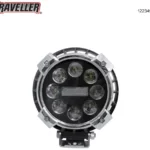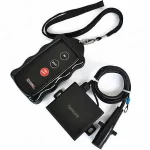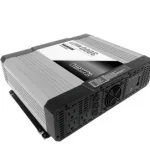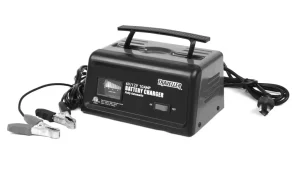
 10 AMP • 6 VOLT/12 VOLT • BATTERY CHARGER
10 AMP • 6 VOLT/12 VOLT • BATTERY CHARGER
OWNER’S MANUAL
OVERCHARGING PROTECTION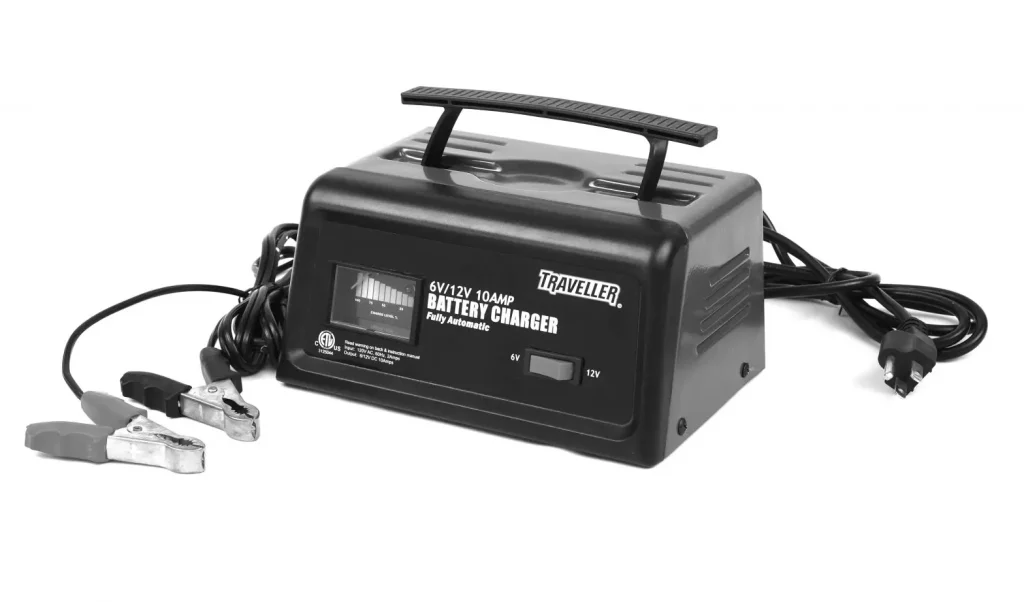
- 10 Amp, 6 Volt/12 Volt
- Fully automatic
- Overcharging protection
- Reverse hook-up protection
- Short circuit protection
- Overheat protection
- Easy-to-read meter
- Eli certified
WARNING
Working in the vicinity of a lead-acid battery is dangerous. Batteries generate explosive gases during normal battery operation. For this reason, it is of utmost importance that each time before using your charger, you read this manual and follow the instructions exactly.
Handling the cord on this product or cords associated with accessories sold with this product will expose you to lead, a chemical known to the State of California to cause cancer and birth defects, or other reproductive harm. Wash hands after handling.
GENERAL BATTERY SAFETY
- Before you use your battery charger, be sure to read all instructions and cautions printed on:
• Battery Charger
• Battery
• Vehicle or unit using battery - Use battery charger on LEAD ACID type rechargeable batteries only, such as used in autos, trucks, tractors, airplanes, vans, RVs, trolling motors, etc. The charger is not intended to supply power to a low vole electrical system other than in an automotive application.
WARNING: Do not use a battery charger for charging dry-cell Lotteries that are commonly used with home appliances. These batteries may burst and cause injury to persons and damage to them properly. - Use only attachments recommended or sold by the manufacturer. Use of non-recommended attachments may result in fire, electric shock, or injury.
- When disconnecting the battery charger, pull by the plug not by the cord. Pulling on the cord may cause damage to the cord or plug.
- Locate the battery power cord so it cannot be stepped on, tripped over, or subjected to damage or stress.
- DO NOT operate charger with damaged cord or plug. Has cord been replaced immediately?
- DO NOT operate charger if it has received a sharp blow, been dropped, or otherwise damaged in any way. Take it to a qualified professional for inspection and repair.
- DO NOT disassemble the charger. Take it to a qualified professional when service or repair is required. Incorrect reassembly may result in electric shock or fire.
- To reduce the risk of electric shock, unplug the charger from the outlet before attempting any maintenance or cleaning.
- DO NOT use an extension cord unless absolutely necessary. Use of an improper extension cord could result in fire or electric shock. If an extension cord must be used, make sure that
• Pins on plug of the extension cord are the same number, size, and shape as those of the plug-on charger.
• Extension cord is properly wired and in good electrical condition.
• Wire size is large enough for AC ampere rating of charger, as specified below:Length of cord (feet): 25 50 100 150 AWG size of cord: 18 18 16 14 - Always charge the battery in a well-ventilated area. NEVER operate in o closed-in or restricted area without adequate ventilation. WARNING: Risk of explosive gas.
- Position charger as far away from battery as DC charger cables permit.
- DO NOT expose the charger to fain or snow.
- NEVER charge a frozen battery. If battery fluid (electrolyte) is frozen, bring it into a warm area to thaw before charging.
- NEVER allow battery acid to drip on the charger when reading specific gravity or filling the battery.
- NEVER seta the battery on top of the charger.
- NEVER place charger directly above battery being charged. Gases from the battery will corrode and damage the charger.
- NEVER touch the battery clips together when the charger is energized.
- NEVER crank engine with the charger attached to the battery.
WARNING: Battery chargers get hot during operation and must have proper ventilation. Air needs to Row around the entire charger. Do not set on flammable items like carpeting, upholstery, paper, cardboard, etc. Will damage leather and melt plastic and rubber.
PERSONAL PRECAUTIONS AND SAFETY
- WARNING: Wear complete eye protection and clothing protection when working with lead-acid batteries.
- Make sure someone is within range of your voice or close enough to come to your aid when you work with or near a lead-acid battery.
- Have plenty of fresh water and soup nearby for use if battery acid contacts skin, clothing, or eyes. If battery acid contacts skin or clothing, wash immediately with soap and water.
- Avoid touching your eyes while working with a battery. Acid particles (corrosion) may get into your eyes! If acid enters your eye, immediately flood eye with running cold water for at least 10 minutes. Get medical attention immediately.
- Remove all personal metal items such os rings, bracelets, necklaces, and watches when working with a lead-acid battery. A lead-acid battery can produce a short-circuit current high enough to weld a ring (or the like) to metal, causing a severe bum.
- Take care not to drop a metal tool or other metal onto the battery. Metal may cause sparking or short-circuit the battery or another electrical device. Sparking may cause an explosion.
- Always operate a battery charger in an open, well-ventilated area.
- NEVER smoke or allow a spark or flame in the vicinity of the battery or engine. Batteries generate explosive gases!
PREPARING TO CHARGE
- Make sure you have a 6 volt or 12 volts lead acid Check the car owner manual to make sure.
- Clean battery terminals. Take core to keep corrosion from coming in contact with your eyes.
- If required, add distilled water in each cell until battery acid reaches levels specified by the battery helps purge excessive gas From cells. Do not overfill. For a battery without cell caps, carefully follow the manufacturer’s recharging instructions.
- Study all battery manufacturer’s specific precautions, such os removing or not removing cell caps while charging, and recommended rates of charge.
- Be sure the area around the battery is well ventilated while the battery is being charged. Gas can be forcefully blown away by using a piece of cardboard or other non-metallic material as a fan.
- If necessary to remove the battery from the vehicle to charge, always remove the grounded terminal from battery first. Make sure all accessories in the vehicle are off, so as not to cause an arc.
- A marine (boat) battery must be removed and charged onshore. To charge it on board requires equipment specially designed for marine use.
BATTERY SIZE/RATING
| BATTERY | RATING | RECHARGE | |
| SIZE | TIME-HOURS’ | ||
| CARS/LIGHT TRUCKS | CCA | RC | |
| 200315 | 40.6 | 33 | |
| 315.55 | 60.85 | 59 | |
| 550850 | 85.15 | 13-Sep | |
| MARINE OR DEEP CYCLE | MCA | API | |
| 220-350 | 24-40 | 5-Mar | |
| 350-600 | 40.7 | 5.9 | |
| 600-935 | 70.104 | 13-Sep |
CCA: COLD CRANKING NAPS RC: RES RVE CAPACITY MCA: MARINE CRANKING AMPS AK AMPERE HOUR
‘Based on a battery of 50% charge.
Not sure of your BATTERY TYPE?: All otrkenolive (cor & truck) batteries are ‘Regulars batteries not “Deep Cycle”. Deep Cycle batteries are used on equipment without alternators or generators like golf cars, personnel carriers, high lifts, floor sweepers, etc.
Not recommended for the Deko Voyager® batteries or similar.
BATTERY CHARGE CONTROLS

6V-12V SWITCH
6V position is selected to charge 6 Volt battery and 12V position is selected to charge 12 Volt battery, take care to determine the battery type.
WARNING: To avoid damage the battery, select the appropriate mode.
AUTOMATIC CHARGING
When the battery reaches the full charge state, the charge current is turned off and the charger switches to the maintainer mode of operation. This action occurs when the meter tapers down to approximately 95%. In this state, the battery voltage is constantly being monitored. When the battery voltage drops to a predetermined value charge will turn on for a few seconds replacing the small amount of energy that was lost while the charge current was at 0 Amps.
METER/LED INDICATOR
The meter gives a reading of the AMP draw on the charger. When a fully discharged battery is connected to the charger, the meter will read the maximum output rating of the charger. The charge current will gradually taper down as the battery approaches full charge. As the charge current tapers, the meter needle will also move down.
When fully charged, the meter needle will suddenly drop to 100% and a green LED will turn on.
NOTE: As the battery approaches the full charge state the meter needle and LED will fluctuate back and forth. For the average size automotive battery, allow 5 to 10 minutes for the battery to stabilize.
NOTE: A buzz or hum is normal when the output cables have been disconnected and the AC power cord is still connected to an electrical source (i.e. wall outlet).
These types of noises will also occur when the green light comes on indicating the battery is “Completely Charged”. Al this point, the charger has stopped charging the battery, but still hums or buzzes until the electrical power is shut off.
When fully charged, the meter needle will suddenly drop to 100% and a green LED will turn on.
READING METER
FULLY DISCHARGED BATTERY
The initial charge current to the battery is typically 10 Amps.
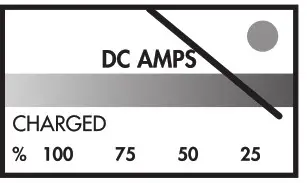
APPROACHING FULL CHARGE
Charge current to the battery is typically 6 Amps.
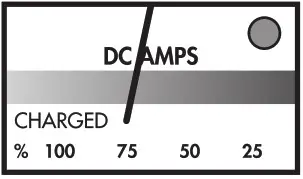
FULLY CHARGED BATTERY
The charge current to the battery is 0 Amps and the green LED is on.
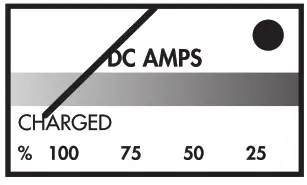
CIRCUIT BREAKER
This battery charger is equipped with a self-resetting circuit breaker. This device protects the charger From temporary overloads. In the event of an overload, the circuit breaker will trip open and after a short cooling-off period will reset automatically. This process is known as cycling and can be recognized by an audible clicking sound.
NOTE: Clicking sound is normal. Wait until the charger automatically resets itself.
CAUTION: Persistent clicking (more than 30 minutes) may indicate reverse connection or shorted battery cells. (See TROUBLESHOOTING)
BATTERY TYPES
Three basic types of lead-acid batteries can be given a charge with this charger:
- Conventional and Low Maintenance,
- Maintenance Free,
- Deep Clyde / Marine
Conventional and Low Maintenance Batteries. These are the antimony/lead batteries. Conventional/Low Maintenance batteries require periodic addition of water to the acid solution (electrolyte). Additional water may be added by removing the filler caps located on the top of the battery.
IMPORTANT: When antimony is known to be one of the materials used in the battery’s construction, that battery is a Low Maintenance/Conventional type.
CAUTION: Some Low Maintenance batteries have o relatively smooth top without any apparent battery filler cops. If, however, the battery manufacturer/ distributor recommends periodic checking of electrolyte
level and provides access to the battery for water additions, the battery is probably a Low Maintenance/ Conventional type.
Maintenance Free Batteries. These are calcium/lead batteries and normally do not require water additions. Therefore, filler caps have been removed From the battery surface. These batteries will have a smooth or sealed appearance.
Deep Cycle Batteries. These heavy-duty batteries are used in boots, construction equipment, sump pumps, etc. They are normally marked DEEP CYCLE on the outside of the case.
OPERATING INSTRUCTIONS: CHARGING BATTERY OUT OF THE VEHICLE
When charging the battery out of the vehicle, take care to determine the battery type. To reduce the risk of a spark near the battery, follow these steps when the battery is outside the vehicle. WARNING: A spark near the battery may cause a battery explosion. WARNING: When removing the battery from the vehicle or boat, disconnect the grounded post first. When disconnecting, make sure all accessories are off, so as not to cause an arc. (NOTE: A marine (boat) battery must be removed and charged on shore. (To charge onboard requires special equipment designed for marine use.) WARNING: When reinstalling the battery, attach the ground post first.
- Check the polarity of battery posts. The battery case will be marked by cock post: POSITIVE (POS, P, +) and NEGATIVE (NEG, N, -). NOTE: The positive battery post usually has a larger diameter than the negative post.
- Connect POSITIVE (RED) charger clamp to POSITIVE (POS, P, +) battery post. Rock clamp bock and forth to make a good connection.
- Position yourself as far away from battery as Then connect NEGATIVE (BLACK) charger clamp to NEGATIVE (NEC, N, battery post. WARNING: Do not face battery when making the final connection. Rock clamp back and forth to make o good connection. FIGURE I shows the connection.
- Plug charger AC cord into a 120-volt outlet.
- Select automatic or manual charging, see Charger
- When the battery is fully charged, unplug the charger from the AC power source.
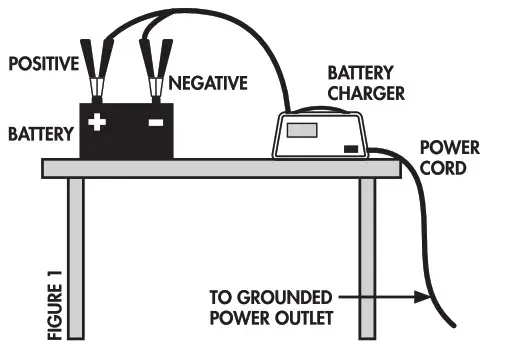
OPERATING INSTRUCTIONS: CHARGING BATTERY IN VEHICLE
When charging the battery in the vehicle, take care to determine the battery type and which pole is grounded. To reduce the risk of a spark near the battery, follow these steps when the battery is inside the vehicle. WARNING: A spark near the battery may cause a battery explosion.
- Position AC power cord and DC charging cords to reduce the risk of damage by hood, door, or moving engine parts.
- Stay clear of fan blades, belts, pulleys, and other parts that can cause injury.
- Check the polarity of battery posts. The battery case will be marked by each post: POSITIVE (POS, P, +) and NEGATIVE (NEG, N, -). NOTE: The positive battery post usually has a larger diameter than the negative post.
- Determine which post of battery is grounded (connected) to the chassis. NOTE: The negative post is normally grounded.
NEGATIVE GROUNDED POST
5A. For a negative-grounded vehicle, connect POSITIVE (RED) clamp from battery charger to POSITIVE (POS, P, +) ungrounded post of the battery. Connect NEGATIVE (BLACK) damp to vehicle chassis or engine block away from battery Connect to o heavy-gauge metal part of the frame or engine block.
WARNING: Do not connect clip to carburetor, fuel lines, or sheet metal body parts. NOTE: Attach clamps
to battery post and twist or rock back and forth several times to make a good connection. This tends to keep clamps from slipping off terminals and helps to reduce risk of sparking.
POSITIVE GROUNDED POST
5B. For a positive-grounded vehicle, connect NEGATIVE (BLACK) clamp from battery charger to NEGATIVE (NEG, N, -) ungrounded post of the battery. Connect the POSITIVE (RED) clamp to vehicle chassis or engine block away from the battery. Connect to a heavy-gauge metal part of the frame or engine block.
- Plug charger AC cord into a 120-volt outlet.
- Select automatic or manual charging, see Charger
- When the battery is fully charged, unplug the charger from the AC power source.
- When the battery is fully charged and the charger is unplugged, (1) remove the clamp from the end of the Negative end of the cable, and (2) remove the clamp from the Positive battery post, in that order.
- Clean and store battery charger.
MAINTENANCE/CLEANING INSTRUCTIONS
Very little maintenance is required for the battery charger. Follow common sense in wiping the charger clean and store in a clean, dry area.
- After use, use a dry cloth to wipe all battery corrosion and other dirt or oil from the clomp, cord, and charger case.
- Secure battery charger cords to prevent damage and premature wear.
- Have any cracked or frayed cords been replaced by a qualified professional?
- Store battery charger in a clean, dry area.
| PROBLEM | POSSIBLE CAUSE | SOLUTION |
| No meter reading. | Charger is not plugged in. Connections are reversed. Poor electrical connection.AC outlet is dead.Battery is defective (will not accept charge). |
Plug in. With charger unplugged, reverse clamps and reconnect (rock back and forth to bite in).Clean clamps and battery poles and reconnect (rock back and forth to bite in). Plug in a lamp or other appliance to check for voltage. Have the battery checked? |
| Charger will not turn on when properly connected to power. | Battery recently used in vehicle and is fully charged. | The battery does not need changing. (If the battery is in a vehicle, turning on headlights will lower battery voltage in a few seconds and charger should then turn on.)
Battery has less than .7 volts, set to Manual and retry |
| The charger will not turn OFF. | The battery has a problem and will not take full charge. | Has the battery checked? (If in MANUAL, switch to AUTOMATIC). |
| Meter needle pulses (fluctuates) every few seconds AFTER THREE HOURS without slowing down. | Two or more batteries are connected in parallel. The battery of 200-ampere hours or larger. The battery is connected to an application that draws a small current (such as a vehicle’s dome light). |
Requires more time to charge: continue charging.
Requires more time to charge: continue charging. Requires more time to charge: continue charging. |
| The charging current is less than the full output rating of the charger. | The battery is partially charged. The battery is defective (battery plates are crusted) and will not accept a full charge. AC power supply is low. |
Continue charging. Have checked and replaced the battery.
Plug charger into another grounded AC outlet. |
| Meter needle moves to the extreme right, remains a short time, then returns to zero, accompanied by a clicking sound. | Severely discharged battery (but otherwise good battery).
In MANUAL with battery connections reversed. The battery is defective (will not accept charge) Charger is cycling after circuit breaking overload. |
Allow charging to continue until the battery has recovered sufficiently to take a charge (Circuit breaker will continue to cycle and needle will swing side to side until the battery has recovered).
Unplug the charger and change to correct connections. Has the battery been checked? Wait until the charger automatically resets itself (DO NOT RETURN FOR SERVICE). |
